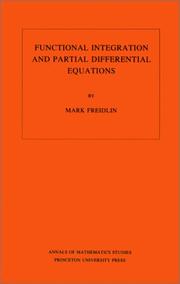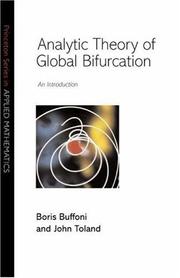| Listing 1 - 2 of 2 |
Sort by
|

ISBN: 0691083541 1400881595 Year: 1985 Publisher: Princeton, N.J.
Abstract | Keywords | Export | Availability | Bookmark
 Loading...
Loading...Choose an application
- Reference Manager
- EndNote
- RefWorks (Direct export to RefWorks)
This book discusses some aspects of the theory of partial differential equations from the viewpoint of probability theory. It is intended not only for specialists in partial differential equations or probability theory but also for specialists in asymptotic methods and in functional analysis. It is also of interest to physicists who use functional integrals in their research. The work contains results that have not previously appeared in book form, including research contributions of the author.
Partial differential equations --- Differential equations, Partial. --- Probabilities. --- Integration, Functional. --- Functional integration --- Functional analysis --- Integrals, Generalized --- Probability --- Statistical inference --- Combinations --- Mathematics --- Chance --- Least squares --- Mathematical statistics --- Risk --- A priori estimate. --- Absolute continuity. --- Almost surely. --- Analytic continuation. --- Axiom. --- Big O notation. --- Boundary (topology). --- Boundary value problem. --- Bounded function. --- Calculation. --- Cauchy problem. --- Central limit theorem. --- Characteristic function (probability theory). --- Chebyshev's inequality. --- Coefficient. --- Comparison theorem. --- Continuous function (set theory). --- Continuous function. --- Convergence of random variables. --- Cylinder set. --- Degeneracy (mathematics). --- Derivative. --- Differential equation. --- Differential operator. --- Diffusion equation. --- Diffusion process. --- Dimension (vector space). --- Direct method in the calculus of variations. --- Dirichlet boundary condition. --- Dirichlet problem. --- Eigenfunction. --- Eigenvalues and eigenvectors. --- Elliptic operator. --- Elliptic partial differential equation. --- Equation. --- Existence theorem. --- Exponential function. --- Feynman–Kac formula. --- Fokker–Planck equation. --- Function space. --- Functional analysis. --- Fundamental solution. --- Gaussian measure. --- Girsanov theorem. --- Hessian matrix. --- Hölder condition. --- Independence (probability theory). --- Integral curve. --- Integral equation. --- Invariant measure. --- Iterated logarithm. --- Itô's lemma. --- Joint probability distribution. --- Laplace operator. --- Laplace's equation. --- Lebesgue measure. --- Limit (mathematics). --- Limit cycle. --- Limit point. --- Linear differential equation. --- Linear map. --- Lipschitz continuity. --- Markov chain. --- Markov process. --- Markov property. --- Maximum principle. --- Mean value theorem. --- Measure (mathematics). --- Modulus of continuity. --- Moment (mathematics). --- Monotonic function. --- Navier–Stokes equations. --- Nonlinear system. --- Ordinary differential equation. --- Parameter. --- Partial differential equation. --- Periodic function. --- Poisson kernel. --- Probabilistic method. --- Probability space. --- Probability theory. --- Probability. --- Random function. --- Regularization (mathematics). --- Schrödinger equation. --- Self-adjoint operator. --- Sign (mathematics). --- Simultaneous equations. --- Smoothness. --- State-space representation. --- Stochastic calculus. --- Stochastic differential equation. --- Stochastic. --- Support (mathematics). --- Theorem. --- Theory. --- Uniqueness theorem. --- Variable (mathematics). --- Weak convergence (Hilbert space). --- Wiener process.

ISBN: 0691112983 1400884330 9781400884339 9780691112985 Year: 2016 Publisher: Princeton University Press
Abstract | Keywords | Export | Availability | Bookmark
 Loading...
Loading...Choose an application
- Reference Manager
- EndNote
- RefWorks (Direct export to RefWorks)
Rabinowitz's classical global bifurcation theory, which concerns the study in-the-large of parameter-dependent families of nonlinear equations, uses topological methods that address the problem of continuous parameter dependence of solutions by showing that there are connected sets of solutions of global extent. Even when the operators are infinitely differentiable in all the variables and parameters, connectedness here cannot in general be replaced by path-connectedness. However, in the context of real-analyticity there is an alternative theory of global bifurcation due to Dancer, which offers a much stronger notion of parameter dependence. This book aims to develop from first principles Dancer's global bifurcation theory for one-parameter families of real-analytic operators in Banach spaces. It shows that there are globally defined continuous and locally real-analytic curves of solutions. In particular, in the real-analytic setting, local analysis can lead to global consequences--for example, as explained in detail here, those resulting from bifurcation from a simple eigenvalue. Included are accounts of analyticity and implicit function theorems in Banach spaces, classical results from the theory of finite-dimensional analytic varieties, and the links between these two and global existence theory. Laying the foundations for more extensive studies of real-analyticity in infinite-dimensional problems and illustrating the theory with examples, Analytic Theory of Global Bifurcation is intended for graduate students and researchers in pure and applied analysis.
Differential geometry. Global analysis --- Bifurcation theory. --- Differential equations, Nonlinear --- Stability --- Numerical solutions --- Addition. --- Algebraic equation. --- Analytic function. --- Analytic manifold. --- Atmospheric pressure. --- Banach space. --- Bernhard Riemann. --- Bifurcation diagram. --- Boundary value problem. --- Bounded operator. --- Bounded set (topological vector space). --- Boundedness. --- Canonical form. --- Cartesian coordinate system. --- Codimension. --- Compact operator. --- Complex analysis. --- Complex conjugate. --- Complex number. --- Connected space. --- Coordinate system. --- Corollary. --- Curvature. --- Derivative. --- Diagram (category theory). --- Differentiable function. --- Differentiable manifold. --- Dimension (vector space). --- Dimension. --- Direct sum. --- Eigenvalues and eigenvectors. --- Elliptic integral. --- Embedding. --- Equation. --- Euclidean division. --- Euler equations (fluid dynamics). --- Existential quantification. --- First principle. --- Fredholm operator. --- Froude number. --- Functional analysis. --- Hilbert space. --- Homeomorphism. --- Implicit function theorem. --- Integer. --- Linear algebra. --- Linear function. --- Linear independence. --- Linear map. --- Linear programming. --- Linear space (geometry). --- Linear subspace. --- Linearity. --- Linearization. --- Metric space. --- Morse theory. --- Multilinear form. --- N0. --- Natural number. --- Neumann series. --- Nonlinear functional analysis. --- Nonlinear system. --- Numerical analysis. --- Open mapping theorem (complex analysis). --- Operator (physics). --- Ordinary differential equation. --- Parameter. --- Parametrization. --- Partial differential equation. --- Permutation group. --- Permutation. --- Polynomial. --- Power series. --- Prime number. --- Proportionality (mathematics). --- Pseudo-differential operator. --- Puiseux series. --- Quantity. --- Real number. --- Resultant. --- Singularity theory. --- Skew-symmetric matrix. --- Smoothness. --- Solution set. --- Special case. --- Standard basis. --- Sturm–Liouville theory. --- Subset. --- Symmetric bilinear form. --- Symmetric group. --- Taylor series. --- Taylor's theorem. --- Theorem. --- Total derivative. --- Two-dimensional space. --- Union (set theory). --- Variable (mathematics). --- Vector space. --- Zero of a function.
| Listing 1 - 2 of 2 |
Sort by
|

 Search
Search Feedback
Feedback About UniCat
About UniCat  Help
Help News
News